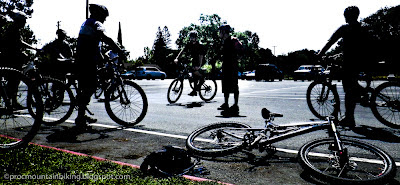
I was drawn to the BetterRide course because it's focus is on core skills that can be practiced through drills - much like a martial art. By mastering the basics, and working at them regularly as part of a riding routine you become a more efficient, competent and therefore faster rider. Just what I was looking for. Day 1 and we were introduced to the two most important things in mountain biking ; having fun, and vision. Of course, it's all about having fun. But we were all there to learn how to improve so we can have more fun and feel less frustrated at our riding. That's where vision, as a first step, came in. By using drills and cones we were taught the art of looking ahead and tackling obstacles two or three at a time and trusting peripheral eyesight to deal with what was directly in front of our wheels. Vision techniques were then combined with a solid, relaxed body position which allowed for correct weight distribution and separation from the bike. After lunch we hit dirt, but not before instructors Dylan and Andy took us through wheelies and manuals. I've neglected to practice these skills in the past. I always made the excuse that my bike was too big and burly to learn on. Dual suspension bikes were not ideal for wheelie practice blah de blah... But after breaking down the techniques and giving demonstrations, we were soon riding the rear wheel. Dylan made a point about pushing the shoulders backwards and "throwing the monkey off your back"... With this in mind I was suddenly pulling wheelies! During the course of the weekend I kept playing with it and whenever I applied correct technique I'd manage a decent wheelie. Also knowing the (significant) difference between wheelie and manual body position means I can now work on those skills separately and hopefully get them trail ready.
I was excited about day 2 ; cornering! We spent the morning doing carpark figure of 8 drills, concentrating on one element of correct body position and vision at a time. Counter steering, dropping weight into the outside foot, getting the outside elbow really up and out and using the hips to keep on track felt really good. I could feel myself settling into a solid stance and the Nomad's front wheel behaved like it was on a rail. After some solid braking technique demos we hit Palo Alto's Arastradero Preserve to put the morning's drills into practice. I found myself hitting some of the corners a little too quickly and fell back on old bad habits to get me through. But when I did employ the new techniques I felt myself settle into a confident stance again. This, plus good vision techniques will really help me rail corners and hopefully improve my overall speed. I just need to keep doing those figure of 8 drills.
Day 3 of our intensive, sun kissed clinic and it was back to the carpark. This time rear wheel lifts coupled with wheelies and manuals to help us clear trail obstacles. And then, switchbacks. After some cone drills we hit Arastradero again to session some real switchbacks. Dylan and Andy gave some solid nuggets of information. For example on uphill switchbacks keep the chest down and vision up to keep the bike balanced as you look through to the exit. Also, gear selection should be for the tightest, steepest part of the switchback. Seems obvious but I often fail on uphills because I'm geared too high for the critical steep bit. On downhill switchbacks, again use good body position and vision, but use the brakes correctly to get through smoothly and quickly. Use the rear to scrub speed, and the front for control. Once you hit the apex, lose the front and roll out.... but don't reapply the front as it will screw up the turn by standing the bike up and pulling it off course. A small, but hugely significant tip and one that will hopefully speed up my Tamarancho descents.





No comments:
Post a Comment